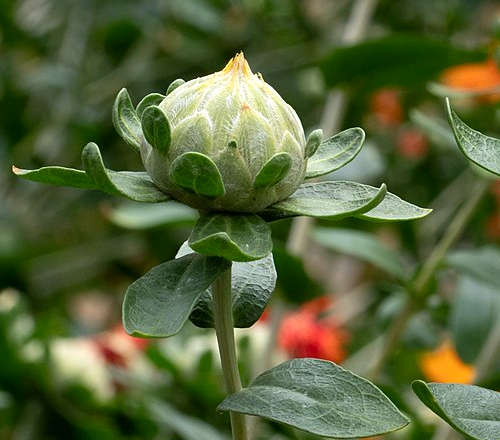Description
Form:
Herb.
Lifespan:
Annual.
Growth rate:
Rapid.
Mature Size:
2-6' (0.6-2m) high.
Flowers:
Many yellow, orange, red, or whitish, florets, with five narrow, pointed petals, appear at
the top of a bulb-shaped flower bud covered with green sepals.
The sepals remain in place to protect the developing seeds.
While the florets are considered self-pollinating, the presence of bees and other safflower
plants nearby improves the number of seed produced.
Bloom:
Flowers appear two months or more after sowing.
A given plant may produce 10 to 150 flower heads and be in flower for 10 to 40 days.
Fruit:
Each floret produces a dry fruit with a single seed (cypsela).
The seeds ripen 120 to 150 days after the plant producing them was sown.
Each flower head may produce 15 to 120 seeds.
Leaves:
Green, rigid, leathery, lance to elliptic shaped, edges saw-toothed with spines or smooth,
smooth on top.
Stems:
Upright, branched, with each branch ending in a single flower head.
Roots:
This plant grows a deep taproot and should be grown in deep soil.
Wildlife:
The flowers attract bees and other nectar and pollen feeding insects.
Birds are attracted to the seeds of the dried flower head.
The plant may need protection from rabbits and other mammals that browse leaves and stems.
Toxic / Danger:
Many varieties have spines on leaf edges. Extracts of safflower should not be consumed by
mothers who are breastfeeding because, based on studies with mice, nursing infants will be
harmed.
Origin:
Iran and Turkey. Saffron has been cultivated for at least 4,500 years and has spread
worldwide in countries with arid climates and seasonal rainfall.
Cultivation and Uses
USDA hardiness zones:
3-9.
Heat tolerant:
Yes. Summer varieties are more heat tolerant.
Drought tolerant:
Yes.
Sun:
Full sun.
Planting:
Seeds should be sown 1/4" (6.4mm) deep in well-draining soil with two plants per square
foot (0.1 square meters).
Sow at a time of year to take advantage of the local rainy season.
Summer or winter varieties are selected depending on location and climate.
Soil:
The soil should be well draining and dry, with a pH range of 5-8
(strongly acidic to somewhat alkaline).
Fertilization is desirable if nitrogen or phosphorous levels are low.
This plant tolerates salinity.
Water:
This crop is sown when it can take advantage of the beginning of the rainy season where
it is being grown.
The roots are susceptible to root rot when overwatered, especially in poorly draining soil.
Propagation:
Seed.
Uses:
Safflower is primarily grown in cultivation for the oil from its seeds.
The seed residue from oil extraction is used as cattle feed.
The dried petals were used as a dye and as a saffron substitute in cooking.
It is also used as a flowering ornamental and as a source of birdseed.
Comments
Safflower is a member of the Daisy family (Asteraceae).
In the United States, it is mainly grown in California and Arizona.
Do you have additional information or a different experience for this plant that you would
like to share? Email info@GardenOracle.com. All contributions are welcome and appreciated.



